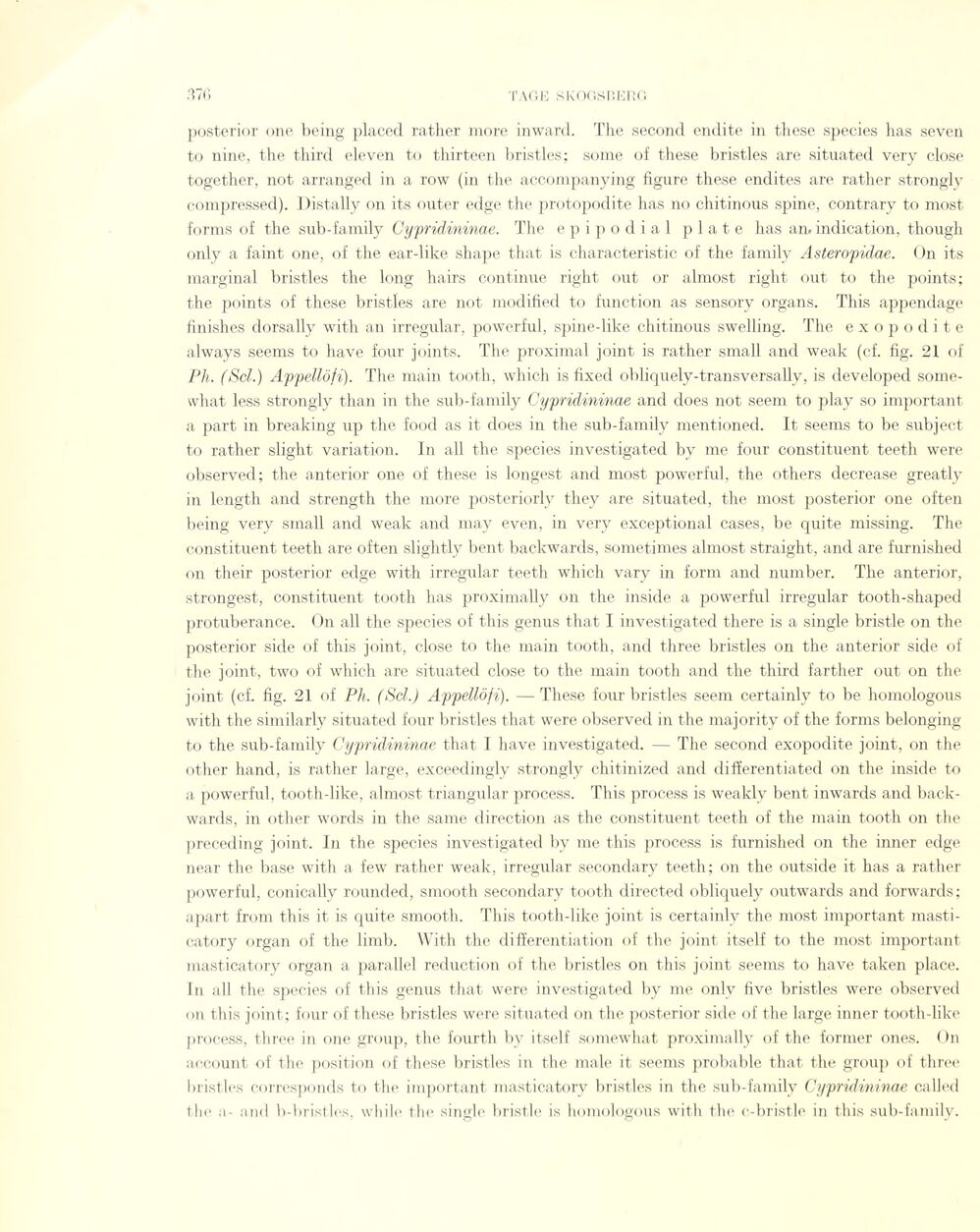
Full resolution (JPEG) - On this page / på denna sida - Sidor ...

<< prev. page << föreg. sida << >> nästa sida >> next page >>
Below is the raw OCR text
from the above scanned image.
Do you see an error? Proofread the page now!
Här nedan syns maskintolkade texten från faksimilbilden ovan.
Ser du något fel? Korrekturläs sidan nu!
This page has never been proofread. / Denna sida har aldrig korrekturlästs.
posterior one being placed rather more inward. The second endite in these species has seven
to nine, the third eleven to thirteen bristles; some of these bristles are situated very close
together, not arranged in a row (in the accompanying figure these endites are rather strongly
compressed). Distally on its outer edge the protopodite has no chitinous spine, contrary to most
forms of the sub-family Cypridininae. The epipodial p late has an. indication, though
only a faint one, of the ear-like shape that is characteristic of the family Asteropidae. On its
marginal bristles the long hairs continue right out or almost right out to the points;
the points of these bristles are not modified to function as sensory organs. This appendage
finishes dorsally with an irregulär, powerful, spine-like chitinous swelling. The exopodite
always seems to have four joints. The proximal joint is rather small and weak (cf. fig. 21 of
Ph. (Sei.) Appellöf i). The main tooth, which is fixed obliquely-transversally, is developed
some-what less strongly than in the sub-family Cypridininae and does not seem to play so important
a part in breaking up the food as it does in the sub-family mentioned. It seems to be subject
to rather slight variation. In all the species investigated by me four constituent teeth were
observed; the anterior one of these is longest and most powerful, the others decrease greatly
in length and strength the more posteriorly they are situated, the most posterior one often
being very small and weak and may even, in very exceptional cases, be quite missing. The
constituent teeth are often slightly bent backwards, sometimes almost straight, and are furnished
on their posterior edge with irregulär teeth which vary in form and number. The anterior,
strongest, constituent tooth has proximally on the inside a powerful irregulär tooth-shaped
protubérance. On all the species of this genus that I investigated there is a single bristle on the
posterior side of this joint, close to the main tooth, and three bristles on the anterior side of
the joint, two of which are situated close to the main tooth and the third farther out on the
joint (cf. fig. 21 of Ph. (Sel.) Appellöfi). —These four bristles seem certainly to be liomologous
with the similarly situated four bristles that were observed in the majority of the forms belonging
to the sub-family Cypridininae that I have investigated. — The second exopodite joint, on the
other hånd, is rather large, exceedingly strongly chitinized and differentiated on the inside to
a powerful, tooth-like, almost triangulär process. This process is weakly bent inwards and
backwards, in other words in the same direction as the constituent teeth of the main tooth on the
preceding joint. In the species investigated by me this process is furnished on the inner edge
near the base with a few rather weak, irregulär secondary teeth; on the outside it has a rather
powerful, conically rounded, smooth secondary tooth directed obliquely outwards and forwards;
apart from this it is quite smooth. This tooth-like joint is certainly the most important
masti-catory organ of the limb. With the differentiation of the joint itself to the most important
masticatory organ a parallel réduction of the bristles on this joint seems to have taken place.
In all the species of this genus that were investigated by me only five bristles were observed
on this joint; four of these bristles were situated on the posterior side of the large inner tooth-like
process, three in one group, the fourth by itself somewhat proximally of the former ones. On
account of the position of these bristles in the male it seems probable that the group of three
bristles corresponds to the important masticatory bristles in the sub-family Cypridininae called
the a- and b-bristlcs, while the single bristle is liomologous with the c-bristle in this sub-family.
<< prev. page << föreg. sida << >> nästa sida >> next page >>